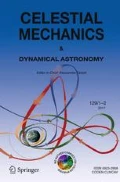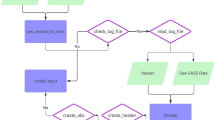Abstract
Satellite laser ranging (SLR) provides an important capability for precise orbit determination and for geophysical parameter estimation to support a number of contemporary geodynamic and oceanographic investigations. The precision of the SLR measurement has improved from the early meter-level systems to the current capabilities of a few centimeters for the best systems. The accuracy of the orbits and geophysical parameter recovery have shown an associated improvement. Polar motion with accuracies of 2 mas, station coordinates better than 10 cm, and interstation baseline rates indicative of tectonic motion are determined routinely with the current set of global SLR data. This discussion reviews the SLR measurement, analysis approach, and some of the recent results derived from the current SLR data set.
Similar content being viewed by others
References
Cappallo, R. J., R. W. King, C. C. Counselman, III, and I. I. Shapiro, ‘Evidence for lunar librations near resonance’,Celest. Mech.,26, 145, 1982.
Centre National d'Etudes Spatiales, Groupe de Recherches de Geodesie Spatiale,Starlette, Toulouse, France, Feb. 1975.
Cheng, M. K., R. J. Eanes, C. K. Shum, B. E. Schutz, and B. D. Tapley, ‘Earth rotation solution from Starlette orbit analysis during the MERIT Campaign,’Proc. of International Conference on Earth Rotation and the Terrestrial Reference Frame, Columbus, Ohio, 1985.
Coates, R. J., H. Frey, J. Bosworth, and G. C. Mead, ‘Space age geodesy: The NASA crustal dynamics project,’IEEE Trans. Geosci. Remote Sens.,GE23(4), 358–368, 1985.
Dickey, J. O., and J. G. Williams, ‘Geodynamical application of lunar laser ranging,’Eos Trans. AGU,63, 301, 1982.
Eanes, R. J., B. E. Schutz, and B. D. Tapley, ‘Earth and ocean tide effects on Lageos and Starlette,’ inProceedings of the Ninth International Symposium on Earth Tides, edited by J. T. Kuo, E. Schweizerbart'she Verlagsbuchhandlung, Stuttgart, 1983.
Felsentreger, T. L., J. G. Marsh, and R. G. Williamson, ‘M 2 ocean tide parameters and the deceleration of the Moon's mean longitude from satellite orbit data,’J. Geophys. Res.,84(B9), 4675–4679, 1979.
Ferrari, A. J., W. S. Sinclair, W. L. Sjogren, J. G. Williams, and C. F. Yoder, ‘Geophysical parameters of the Earth-Moon system,’J. Geophys. Res.,85, 3939–3951, 1980.
Fitzmaurice, M. W., P. O. Minott, J. B. Abeshire, and H. E. Rowe, ‘Prelaunch testing of the laser geodynamic satellite,’NASA TP-1062, Oct. 1977.
Flinn, E. A., ‘Applications of space technology to geodynamics,’Science,213, 89–96, 1981.
Goad, C. C., and B. C. Douglas, ‘Lunar tidal acceleration obtained from satellite-derived ocean tide parameters,’J. Geophys. Res.,83, 306–310, 1978.
Johnson, C. W., C. A. Lundquist, and J. L. Zurasky, ‘The Lageos Satellite,’ paper presented at the International Astronautical Federation XXVIIth Congress, Anaheim, Calif., Oct. 10–16, 1976.
Lambeck, K., A. Cazenave, and G. Balmino, ‘Solid earth and ocean tides estimated from satellite orbit analyses,’Rev. Geophys. Space Phys.,12, 421–434, 1974.
Lambeck, K.,The Earth's Variable Rotation: Geophysical Causes and Consequences, Cambridge Univ. Press, London, 1980.
Lambeck, K., and R. Coleman, ‘The Earth's shape and gravity field: A report of progress from 1958 to 1982,’Geophys. J. R. Astr. Soc.,74, 25–54, 1983.
Langley, R. B., R. W. King, and I. I. Shapiro, ‘Earth rotation from lunar laser ranging,’J. Geophys. Res.,86, 913, 1981a.
Langley, R. B., R. W. King, I. I. Shapiro, R. D. Rosen, and D. A. Salstein, ‘Atmospheric angular momentum and the length of day: A common fluctuation with a period near 50 days,’Nature,294, 730, 1981b.
Lerch, F. J., B. H. Putney, C. A. Wagner, and S. M. Klosko, ‘Goddard earth models for oceanographic applications (GEM 10B and 10C),’Marine Geod.,5(2), 145–187, 1981.
Lerch, F. J., S. M. Klosko, and G. B. Patel, ‘A gravity model for crustal dynamics (GEM-L2),’J. Geophys. Res.,90(B11), 9301–9311, September 30, 1985.
Marini, J. W., and C. W. Murray, ‘Correction of laser range tracking data for atmospheric refraction at elevations above 10 degrees,’ NASA TM X-70555, 1973.
Marsh, J. G., F. J. Lerch, and R. G. Williamson, ‘Precision geodesy and geodynamics using Starlette laser ranging,’J. Geophys. Res.,90(B11), 9335–9345, September 30, 1985.
Marsh, J. G., and R. G. Williamson, ‘Precision orbit computations with Starlette,Bull. Geod.,52(1), 7182, 1978.
Melbourne, W., R. Anderle, M. Feissel, R. King, D. McCarthy, D. Smith, B. Tapley, and R. Vicente,Project MERIT Standards, U. S. Naval Observatory Circular No. 167, Washington, D. C., Dec. 27, 1983.
Minster, J. B., and T. H. Jordan, ‘Present-day plate motions,’J. Geophys. Res.,83(B11), 1978.
NASA Office of Space and Terrestrial Applications,Application of Technology to Crustal Dynamics and Earth Research, NASA Tech. Paper 1464, Aug. 1979.
National Research Council, Committee on Geodesy,Geodesy: Trends and Prospects, Assembly of Mathematical and Physical Sciences, 1978.
Robertson, D. S., W. E. Carter, B. D. Tapley, B. E. Schutz, and R. J. Eanes, ‘Polar motion measurements: Subdecimeter accuracy verified by intercomparison,’Science,229, 1259–1261, September 20, 1985.
Schutz, B. E., B. D. Tapley, and R. J. Eanes, ‘Earth rotation from Lageos laser ranging,’BIH Annual Report for 1980, D27-D29, Paris, 1981.
Schutz, B. E., R. J. Eanes, and B. D. Tapley, ‘The SLR operational center series ERP(CSR)84L02,’Proc. of International Conference on Earth Rotation and the Terrestrial Reference Frame, Columbus, Ohio, 1985.
Silverberg, E. C., T. Cahill, and J. Dorman, ‘Relative lateration across the Los Angeles Basin using a satellite laser ranging system,’Bull. Geod.,56, 329–340, 1982.
Smith, D. E., F. J. Lerch, J. G. Marsh, C. A. Wagner, R. Kolenkiewicz, and W. D. Kahn, ‘Contributions to the national geodetic satellite program by Goddard Space Flight Center,’J. Geophys. Res.,81(5), 1006–1026, Feb. 1976.
Smith, D. E., D. C. Christodoulidis, P. J. Dunn, and M. H. Torrence, ‘Geodetic parameters estimated from Lageos laser data, SL5,’ Fifth Annual NASA Geodynamics Program Conference and Crustal Dynamics Project Review, Washington, D. C., 1983.
Smith, D. E., D. C. Christodoulidis, R. Kolenkiewicz, P. J. Dunn, S. M. Klosko, M. H. Torrence, S. Fricke and S. Blackwell, ‘A global geodetic reference frame from Lageos ranging (SL5.1AP).J. Geophys. Res.,90(B11), 9221–9234, September 30, 1985.
Stolz, A., and D. R. Larden, ‘Seasonal displacement and deformation of the earth by the atmosphere,’J. Geophys. Res.,84(B11), 6185–6194, 1979.
Tapley, B. D., B. E. Schutz, and R. J. Eanes, ‘Global station coordinate solution from Lageos laser ranging,’Eos Trans. AGU,61, 1980a.
Tapley, B. D., and G. H. Born, ‘The Seasat precision orbit determination experiment,’J. Astronaut. Sci.,XXVIII(4), 315–326, 1980b.
Tapley, B. D., G. H. Born, and M. E. Parke, ‘The Seasat altimeter data and its accuracy assessment,’J. Geophys. Res.,87(C5), 3179–3188, April 30, 1982a.
Tapley, B. D., B. E. Schutz, and R. J. Eanes, ‘A critical analysis of satellite laser ranging data,’ inLaser Ranging Instrumentation, vol. II,Proceedings of the 4th International Workshop, pp. 523–567, Geodetic Institute, Bonn University, Bonn, 1982b.
Tapley, B. D., Polar motion and earth rotation,Rev. Geophys.,21(3), 569–573, 1983.
Tapley, B. D., R. J. Eanes, and B. E. Schutz, ‘UT/CSR analysis of earth rotation from Lageos SLR data,’Proc. of International Conference on Earth Rotation and the Terrestrial Reference Frame, Columbus, Ohio, 1985.
Tapley, B. D., B. E. Schutz, and R. J. Eanes, ‘Station coordinates, baselines, and earth rotation from Lageos laser ranging: 1976–1984, ‘J. Geophys. Res.,90(B11), 9235–9248, September 30, 1985.
Wahr, J. M., ‘Body tides on an elliptical, rotating, elastic, and oceanless earth,’Geophys. J. R. Astronaut. Soc.,64(3), 1981.
Wilkins, G. A. (Ed.),Project MERIT: A Review of the Techniques to Be Used During Project MERIT to Monitor the Rotation of the Earth, p. 77, Royal Greenwich Observatory, Herstmonceux, 1980.
Yoder, C. F., J. G. Williamson, J. O. Dickey, B. D. Tapley, R. J. Eanes, and B. E. Schutz, ‘Secular variations of the earth's gravitational harmonicJ 2 coefficient from Lageos and nontidal acceleration of earth rotation,’Nature,303(5920), 757–762, June 30, 1983.
Author information
Authors and Affiliations
Rights and permissions
About this article
Cite this article
Tapley, B.D., Schutz, B.E. & Eanes, R.J. Satellite laser ranging and its applications. Celestial Mechanics 37, 247–261 (1985). https://doi.org/10.1007/BF02285050
Issue Date:
DOI: https://doi.org/10.1007/BF02285050




